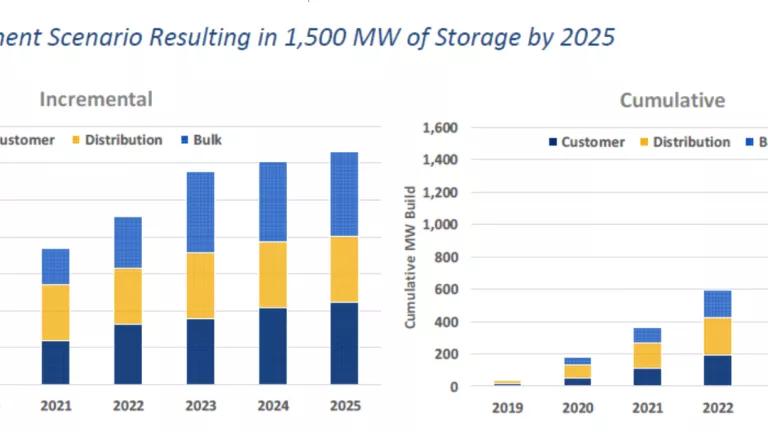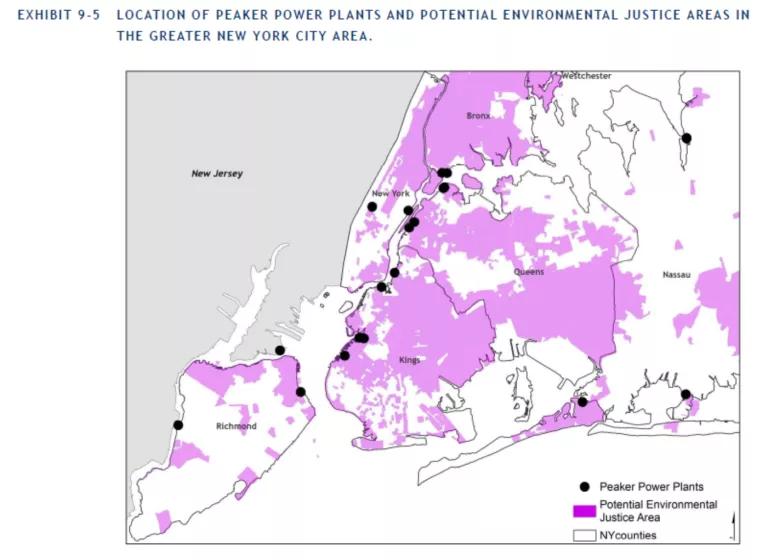NY’s Energy Storage Roadmap for a Clean, Flexible Grid

New York State has released its Energy Storage Roadmap delineating the path forward for an ambitious and rapid scaling up of projects in New York to reach a goal of 1.5 gigawatts (GW) of energy storage by 2025. The state estimates that the total benefits for New York from this amount of storage would be more than $2 billion, and that it will also avoid more than 1 million tons of carbon pollution over 10 years, by avoiding use of the most polluting power plants during system peaks (the days and times with the highest electricity demand). There will be a larger goal for 2030 to be announced later this year, as required by legislation signed in 2017.
Currently there are almost 60 megawatts (MW) of installed energy storage available to serve New York utility customers, with another 500 MW in planning stages.
The Roadmap includes recommendations for actions to be implemented in the short term to accelerate the adoption of storage projects across the state, including:
- Lots of funding: $350 million in market acceleration incentives, including a $200 million investment in storage-related projects from the New York Green Bank, and inclusion of solar plus storage projects in an expanded NY-Sun program
- Changing utility rates, utility solicitations, and carbon values to reflect the benefits and values of storage projects to the electric system
- Continued efforts to address permitting and siting challenges and reduce soft costs for installation of the batteries that store energy
- Recommend changing wholesale electricity market rules to encourage storage participation, including allowing use of storage for both distribution system and wholesale system needs, which will provide greater value for utility customers
Importance of storage
Energy storage allows greater integration of renewable energy in the New York State electricity market where utilities buy power, by charging when renewables’ output is high and discharging when there is more demand. There are also changes happening in the New York State grid that make near-term build out of significant storage resources even more valuable, including the planned shutdown of the troubled Indian Point nuclear plant north of New York City, and the state’s Clean Energy Standard, requiring half of the state’s electric load to be powered by renewables by 2030.
There are three segments of the storage market outlined in the Roadmap, which are each projected to reach 500 MW, approximately equal thirds of the goal:
- Customer‐sited storage and paired on‐site solar and storage:
Includes batteries that can take electricity from the grid and/or from on-site solar systems, as well as microgrids, and vehicle-grid integration (electric vehicle charging management). - Distribution system:
Includes expanded non‐wires alternatives to traditional utility infrastructure, community distributed (locally produced) generation (CDG) and storage, and storage that uses the energy regenerated when electric trains brake. - Large scale system:
Includes large scale storage with renewables and standalone storage for specific uses, including grid services (capacity, ancillary services, short‐duration frequency regulation), to make the grid work better, and hybridizing peaker plants with onsite storage so they can run more cleanly.
The Roadmap also details opportunities to reduce soft costs, and references the City University of New York Distributed Generation Hub’s work with a broad partnership to address barriers and challenges. Their site has a number of technical resources to assist owners, installers, and local permitting agencies with some of the complex issues related to solar-plus-storage projects. As the market expands quickly, addressing these issues will be critical.
Environmental benefits
The significant pollution savings estimated in the Roadmap are also discussed in its draft generic environmental impact statement, which includes a map of peaker plants (that produce more pollution than other power plants) and only operate on the days when there is the most demand on the electric grid (map below). The use of these plants can be reduced or avoided entirely through the use of energy storage, energy efficiency, and other peak reduction programs.

The New York Battery and Energy Storage Technology Consortium (NY-BEST) and Strategen Consulting released a study last year modeling how storage could offset peaker plant demand from New York City power plants, and the Roadmap has an additional study looking at peaker plants in New York City, their attributes, and the potential pollution reductions from storage deployment. The Roadmap study indicates that for peaker units that run less than four hours at a time on average, their emissions contain twice as much carbon and 20 times the nitrogen oxides (NOx) emissions of a typical thermal plant. In addition, because they operate at peaks coincident with extreme heat events, these plants are also emitting NOx, sulfur oxides, and particulates when they are the most harmful. These pollutants form ground-level ozone (and form more of it in hot, sunny weather), which causes asthma and other serious health problems.
Other important storage opportunities
Con Edison has recently received approval for a demonstration project under the Reforming the Energy Vision initiative to explore vehicle-to-grid integration, deploying electric school buses that would be used as mobile battery storage in the summer. Electric school buses are a boon to air quality, avoiding diesel buses' tailpipe emission pollution in the residential neighborhoods they drive through, and reducing the emissions exposure of their young passengers who are most vulnerable to air pollutants. In addition, being able to use the buses’ batteries to store and discharge energy in the summer, when they’re not being driven and are plugged in, benefits the grid and makes the buses more economical on the whole. This is just one of the many opportunities to implement smart vehicle-to-grid integration; benefiting vehicle owners and the electric system in tandem, while improving air quality for everyone by avoiding tailpipe emissions.
As the heat of summer is upon us again, it’s great to see that New York has a lot to look forward to in the energy storage space.

